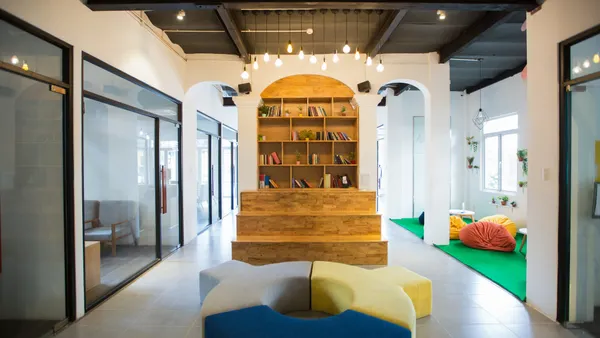Dive Brief:
- Office leasing demand continued to recover in the third quarter, growing 0.4% from Q2, to 50.4 million square feet, according to a U.S. office market dynamics report by JLL. Demand over the past six months has reached 86% of pre-pandemic levels, the report says.
- As the supply pipeline shrinks, availability has begun to decline, with net absorption improving by 10% quarter over quarter. A record volume of inventory is also being removed from the office market for conversion and redevelopment, leading to the national office market tightening for the first time since 2019, JLL said in an Oct. 8 release.
- Despite hybrid workplace strategies dominating the overarching market, return-to-office momentum continues to build, with office attendance rates reaching a post-pandemic record in Q3 as some large employers increase their in-office requirements, JLL says.
Dive Insight:
A second quarter of leasing activity acceleration and the continued slowdown of office space downsizing are steadily normalizing the office market, according to the report. The economic landscape has also shifted significantly in the past three months due to the Federal Reserve’s interest rate cut in September, a relatively stable labor market and strong corporate earnings, JLL says.
Transaction volume is likely to continue increasing in conjunction with expected rate cuts as valuations recover and capital costs decline, JLL says, noting that its pipeline of office transactions has grown by more than 20% year over year.
The Fed’s decision to cut the main federal funds interest rate by half a percentage point would support “more than a moderate improvement,” in commercial real estate investment, according to Richard Barkham, global chief economist and head of Americas research at CBRE.
Gateway and secondary office markets outperformed the national leasing rate, growing 2.5% and 4.6%, respectively, quarter to quarter, while tertiary market leasing fell 18.7% in that period. Outlook for long-term office demand also continues to improve as employers push for greater office attendance.
Growth markets in the Sun Belt also continued to outperform national totals, growing 9.4% quarter over quarter and reaching 96% of pre-pandemic leasing activity over the past six months. JLL attributed these markets’ outpaced leasing recovery to corporate relocations and expansions out of gateway markets in favor of lower-cost Sun Belt secondary markets.
Direct asking rent growth has also continued to grow year over year, but growth is slowing, despite the slowdown in availability, JLL says.
Concessions also remain elevated, while more activity shifts to capital-light transactions, prompting a rise in renewals and subleases that now comprise nearly 60% of leasing activity, per the report. “While renewals or subleases generally carry discounts for face rental rates and concessions, a more granular look at each of these segments … [shows] rents and concessions continuing to grow,” JLL says.
Many of the largest office tenants in the U.S. are still trimming space or relocating to more efficient buildings as they face lease expirations in their portfolio, driving a significant impact in overall activity. While more tenants are growing their real estate portfolios than those shrinking their footprints, downsizing tenants tend to be considerably larger, leading to a net negative impact in absorption, JLL says.
As more large tenants begin to increase transaction volume, active tenant requirements are moderating, declining 2.9% quarter over quarter. While this could potentially signal a slowdown in leasing activity surrounding the election, declines are also driven by tenants that are accelerating their decision-making processes and spending less time “prospecting the market,” per the report.
“Any election always gives corporate decision-making an excuse to punt and avoid a decision, so we'll see if that opens things up a little bit,” Michael Lirtzman, head of office agency leasing for the U.S. at Colliers, said in an interview. “I'm cautiously optimistic that we're starting to get past the bottom and see things turn the corner. But we need those macro factors to get in line and get past some of the uncertainty of the fourth quarter right now.”










